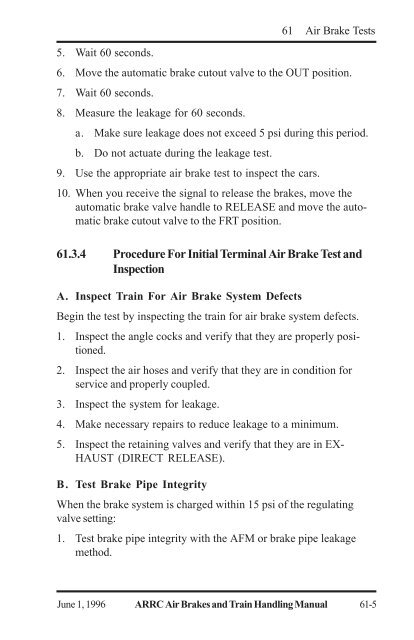Air Brakes and Train Handling Rules - Alaska Railroad
Air Brakes and Train Handling Rules - Alaska Railroad Air Brakes and Train Handling Rules - Alaska Railroad
61 Air Brake Tests1. Charge the brake system to within 15 psi of the equalizing reservoiras indicated by an accurate gauge at the rear of the train.NOTE: Air flow must not exceed 60 CFM.2. When you receive a signal to apply the brakes, make a 20 psibrake pipe reduction.3. Inspect the car(s) or train according to the appropriate air braketest.4. When you receive a signal to release the brakes, move theautomatic brake valve handle to RELEASE.NOTE: After the air brake test is completed, the Air FlowIndicator does not need to return to its original position if therequired air pressure has been restored to the rear of thetrain and the brakes have released.61.3.3 Brake Pipe Leakage MethodThe brake pipe leakage method tests brake pipe integrity by measuringthe amount of leakage in a closed system.A. When To Use Brake Pipe Leakage MethodIf the train does not meet AFM test conditions, conduct a brake pipeleakage test.B. Procedure For Conducting Leakage TestTo conduct a leakage test:1. Charge the train brake system to within 15 psi of the equalizingreservoir as indicated by an accurate gauge at the rear of thetrain.2. Wait for the signal to apply the brakes.3. When you receive the signal, reduce brake pipe pressure by20 psi.4. Allow the brake pipe exhaust to stop.61-4 ARRC Air Brakes and Train Handling Manual June 1, 1996
61 Air Brake Tests5. Wait 60 seconds.6. Move the automatic brake cutout valve to the OUT position.7. Wait 60 seconds.8. Measure the leakage for 60 seconds.a. Make sure leakage does not exceed 5 psi during this period.b. Do not actuate during the leakage test.9. Use the appropriate air brake test to inspect the cars.10. When you receive the signal to release the brakes, move theautomatic brake valve handle to RELEASE and move the automaticbrake cutout valve to the FRT position.61.3.4 Procedure For Initial Terminal Air Brake Test andInspectionA. Inspect Train For Air Brake System DefectsBegin the test by inspecting the train for air brake system defects.1. Inspect the angle cocks and verify that they are properly positioned.2. Inspect the air hoses and verify that they are in condition forservice and properly coupled.3. Inspect the system for leakage.4. Make necessary repairs to reduce leakage to a minimum.5. Inspect the retaining valves and verify that they are in EX-HAUST (DIRECT RELEASE).B. Test Brake Pipe IntegrityWhen the brake system is charged within 15 psi of the regulatingvalve setting:1. Test brake pipe integrity with the AFM or brake pipe leakagemethod.June 1, 1996 ARRC Air Brakes and Train Handling Manual 61-5
- Page 1 and 2: Air BrakesandTrain HandlingRules
- Page 3 and 4: Glossary61.5 Yard Movement Test ...
- Page 5 and 6: Glossary63.6.2 Inspecting For Leaka
- Page 7 and 8: Glossary66 Locomotive Equipment and
- Page 9 and 10: Glossary68 EOT Telemetry Devices...
- Page 11 and 12: 60 Locomotive Engineer Responsibili
- Page 13 and 14: 60 Locomotive Engineer Responsibili
- Page 15 and 16: 61 AIR BRAKE TESTS61 Air Brake Test
- Page 17: 61.3 Initial Terminal Air Brake Tes
- Page 21 and 22: 61 Air Brake Testscompleted satisfa
- Page 23 and 24: 61.7 Application and Release Test61
- Page 25 and 26: 61 Air Brake Tests3. Once the train
- Page 27 and 28: 61 Air Brake Tests7. Cut the automa
- Page 29 and 30: 62 Operating Locomotive Equipment62
- Page 31 and 32: 62 Operating Locomotive EquipmentFi
- Page 33 and 34: 62 Operating Locomotive Equipment3.
- Page 35 and 36: 62 Operating Locomotive Equipment5.
- Page 37 and 38: 62 Operating Locomotive Equipment62
- Page 39 and 40: 62 Operating Locomotive Equipment8.
- Page 41 and 42: 62 Operating Locomotive Equipment4.
- Page 43 and 44: 62 Operating Locomotive Equipment3.
- Page 45 and 46: 62 Operating Locomotive Equipment62
- Page 47 and 48: 62 Operating Locomotive Equipment62
- Page 49 and 50: 62 Operating Locomotive Equipment2.
- Page 51 and 52: 62 Operating Locomotive Equipment62
- Page 53 and 54: 62.11.2 Restoring Operating Control
- Page 55 and 56: 63 Train Equipment and Operation•
- Page 57 and 58: 63 Train Equipment and OperationFig
- Page 59 and 60: 63 Train Equipment and Operation63.
- Page 61 and 62: 63 Train Equipment and Operation63.
- Page 63 and 64: 63 Train Equipment and Operation63.
- Page 65 and 66: 63 Train Equipment and Operation•
- Page 67 and 68: 63 Train Equipment and Operation63.
61 <strong>Air</strong> Brake Tests5. Wait 60 seconds.6. Move the automatic brake cutout valve to the OUT position.7. Wait 60 seconds.8. Measure the leakage for 60 seconds.a. Make sure leakage does not exceed 5 psi during this period.b. Do not actuate during the leakage test.9. Use the appropriate air brake test to inspect the cars.10. When you receive the signal to release the brakes, move theautomatic brake valve h<strong>and</strong>le to RELEASE <strong>and</strong> move the automaticbrake cutout valve to the FRT position.61.3.4 Procedure For Initial Terminal <strong>Air</strong> Brake Test <strong>and</strong>InspectionA. Inspect <strong>Train</strong> For <strong>Air</strong> Brake System DefectsBegin the test by inspecting the train for air brake system defects.1. Inspect the angle cocks <strong>and</strong> verify that they are properly positioned.2. Inspect the air hoses <strong>and</strong> verify that they are in condition forservice <strong>and</strong> properly coupled.3. Inspect the system for leakage.4. Make necessary repairs to reduce leakage to a minimum.5. Inspect the retaining valves <strong>and</strong> verify that they are in EX-HAUST (DIRECT RELEASE).B. Test Brake Pipe IntegrityWhen the brake system is charged within 15 psi of the regulatingvalve setting:1. Test brake pipe integrity with the AFM or brake pipe leakagemethod.June 1, 1996 ARRC <strong>Air</strong> <strong>Brakes</strong> <strong>and</strong> <strong>Train</strong> H<strong>and</strong>ling Manual 61-5



